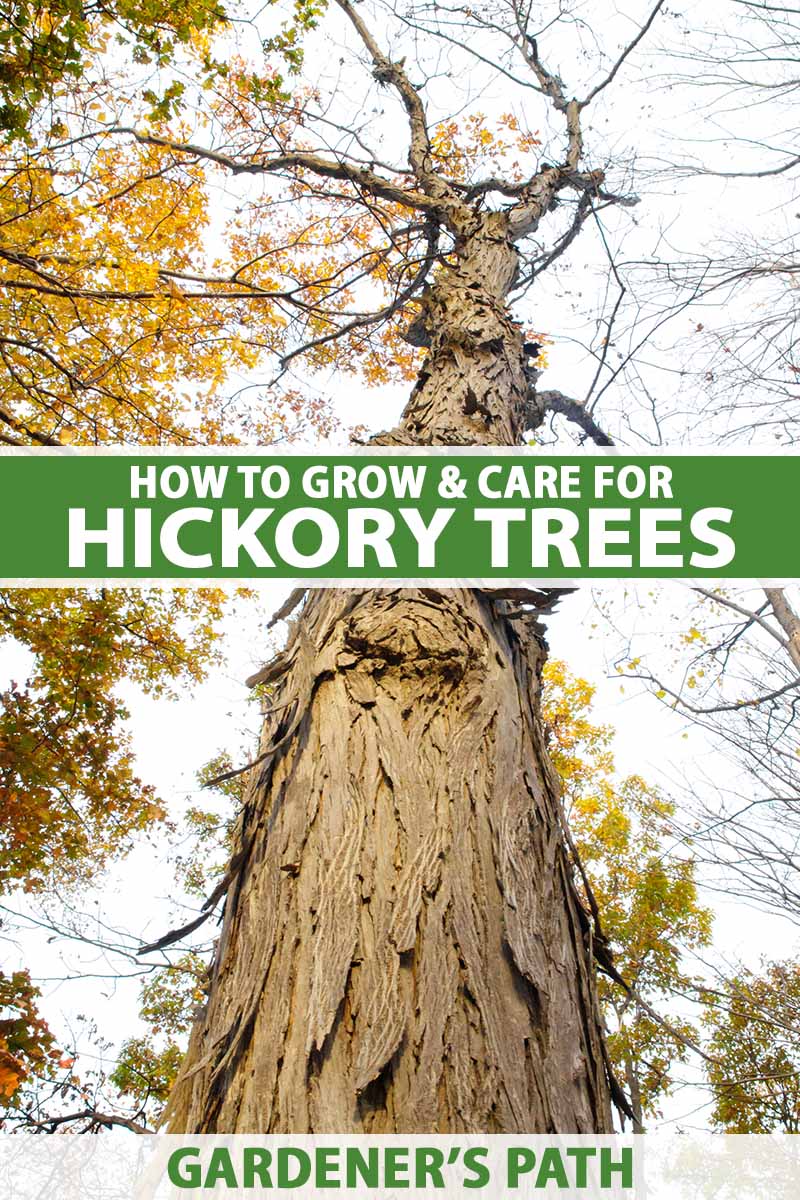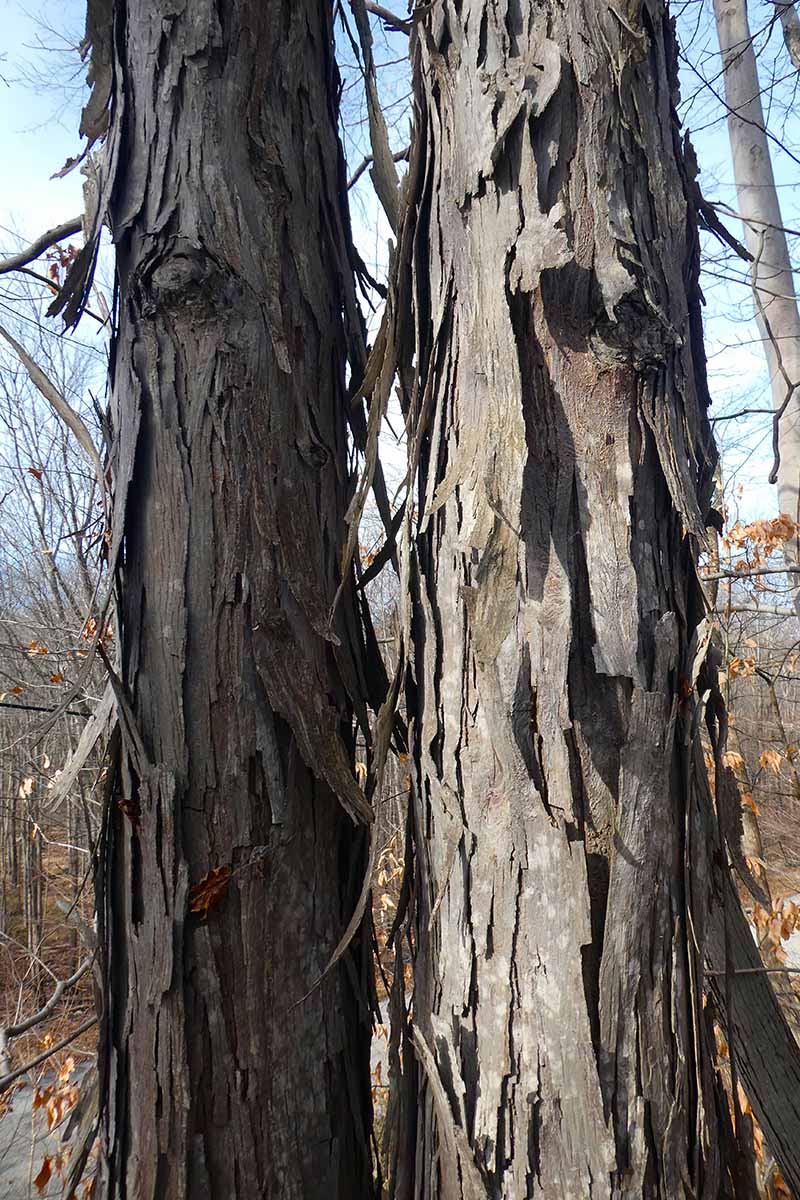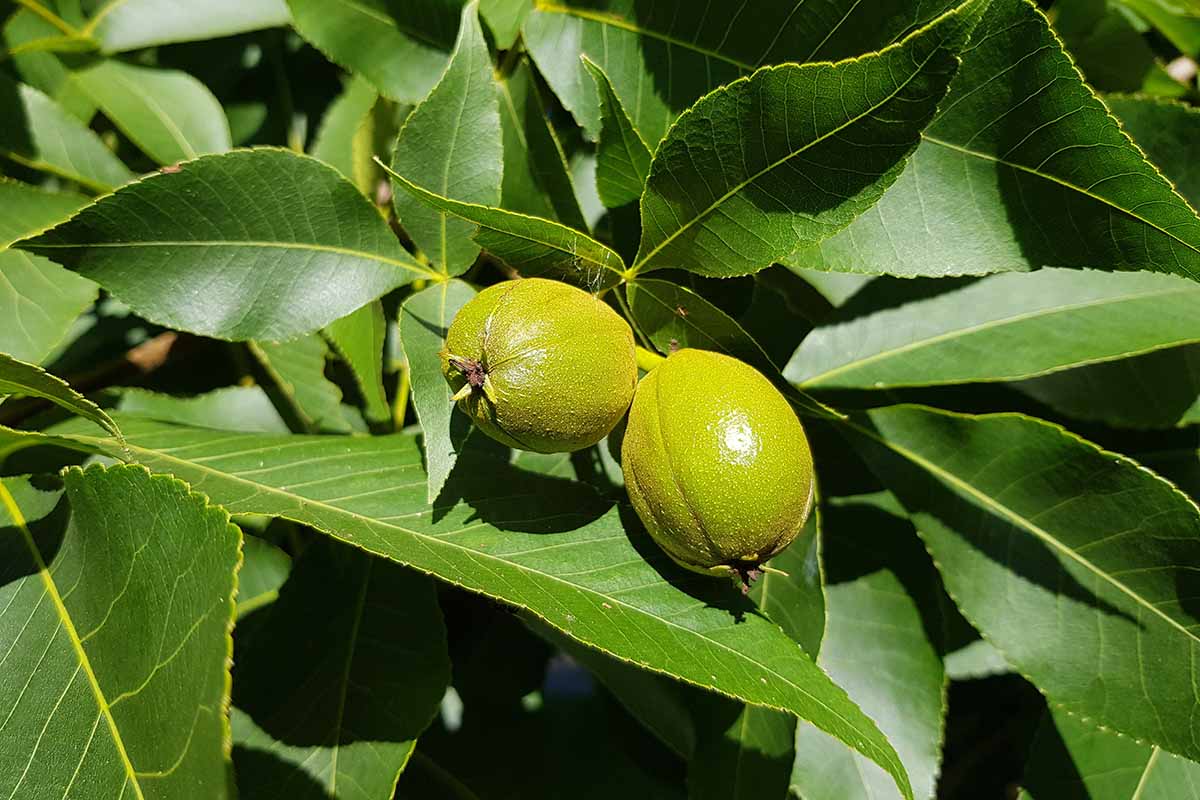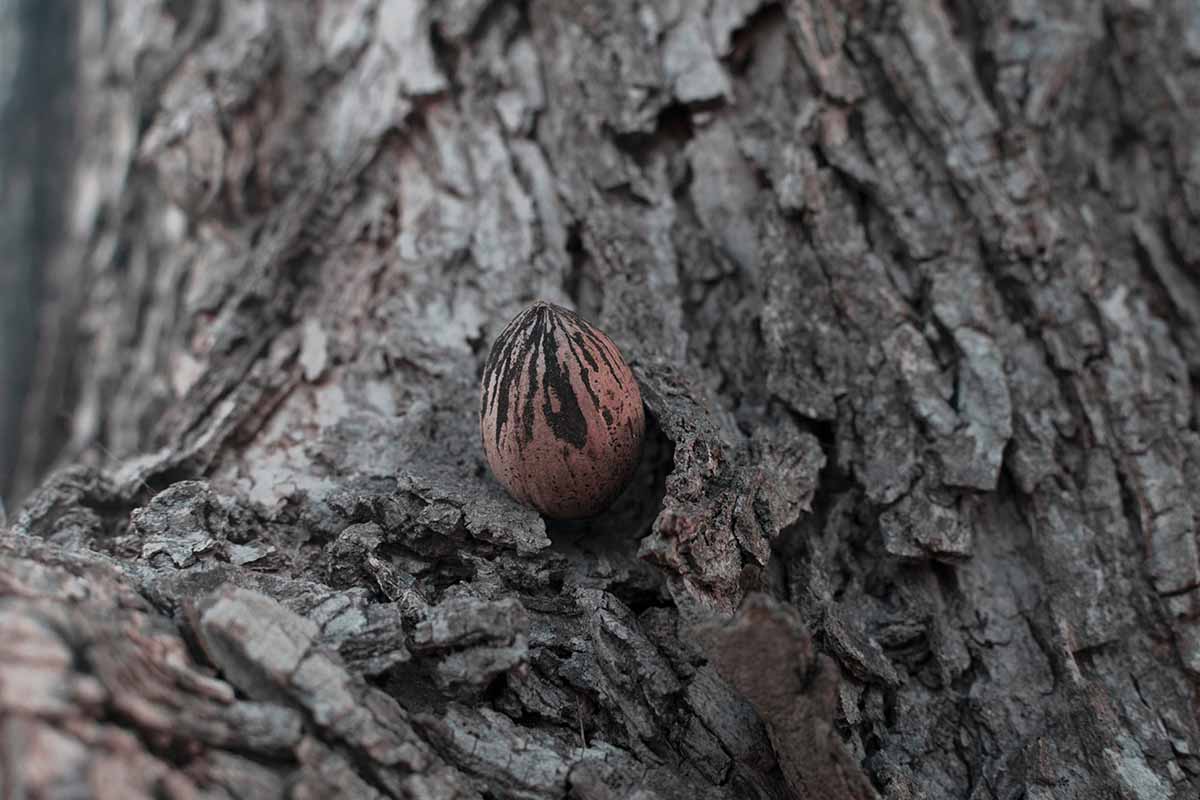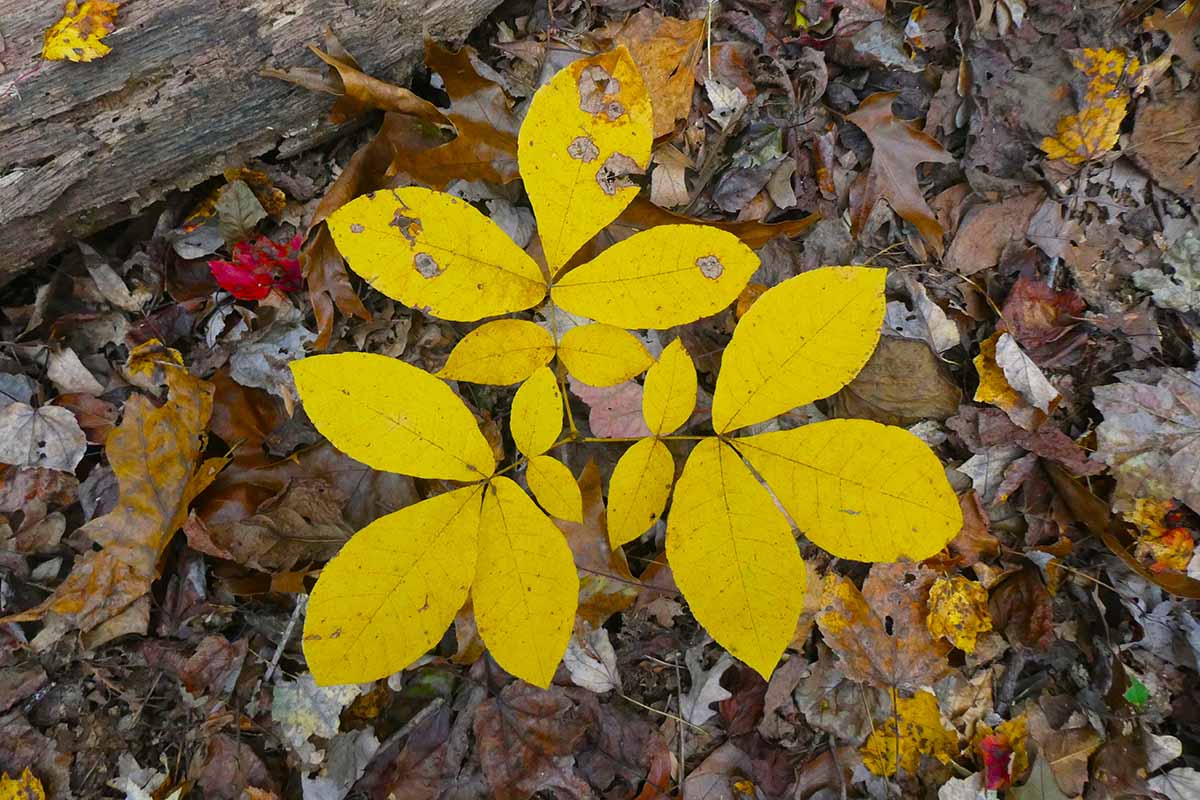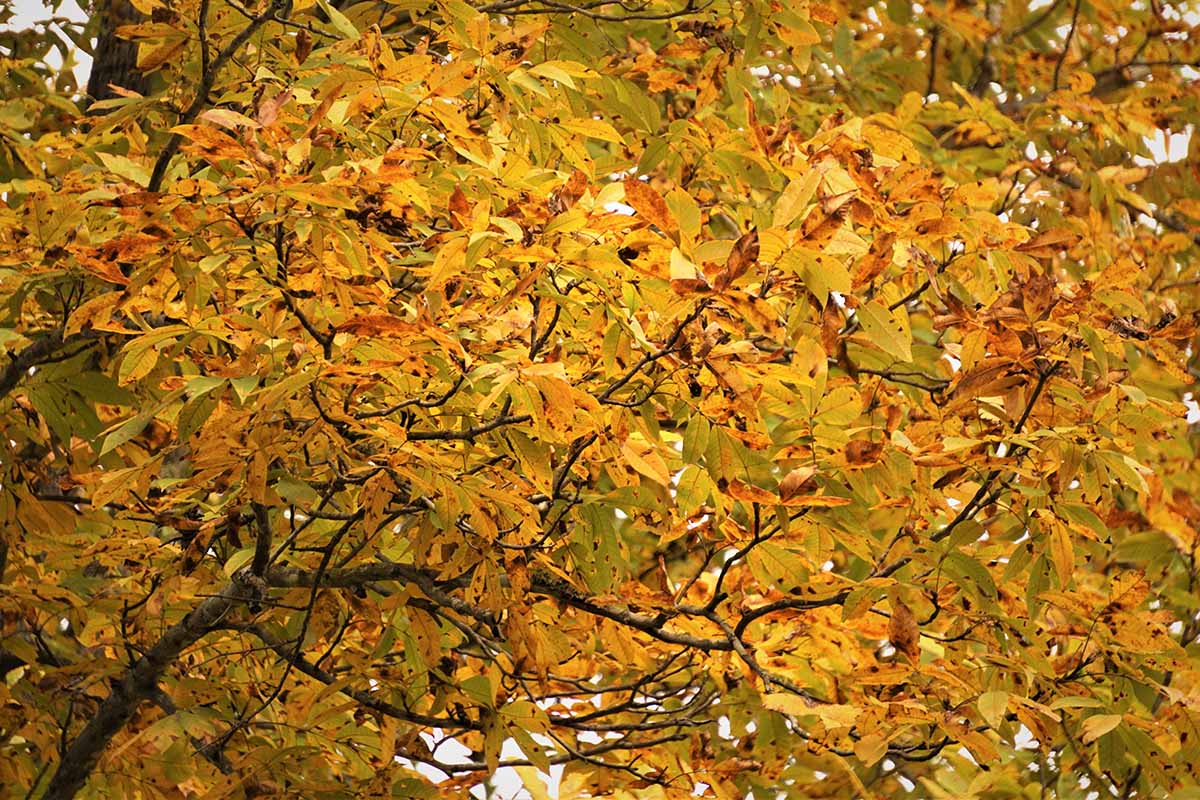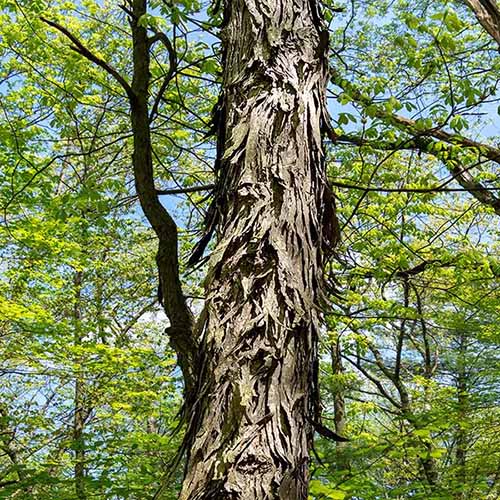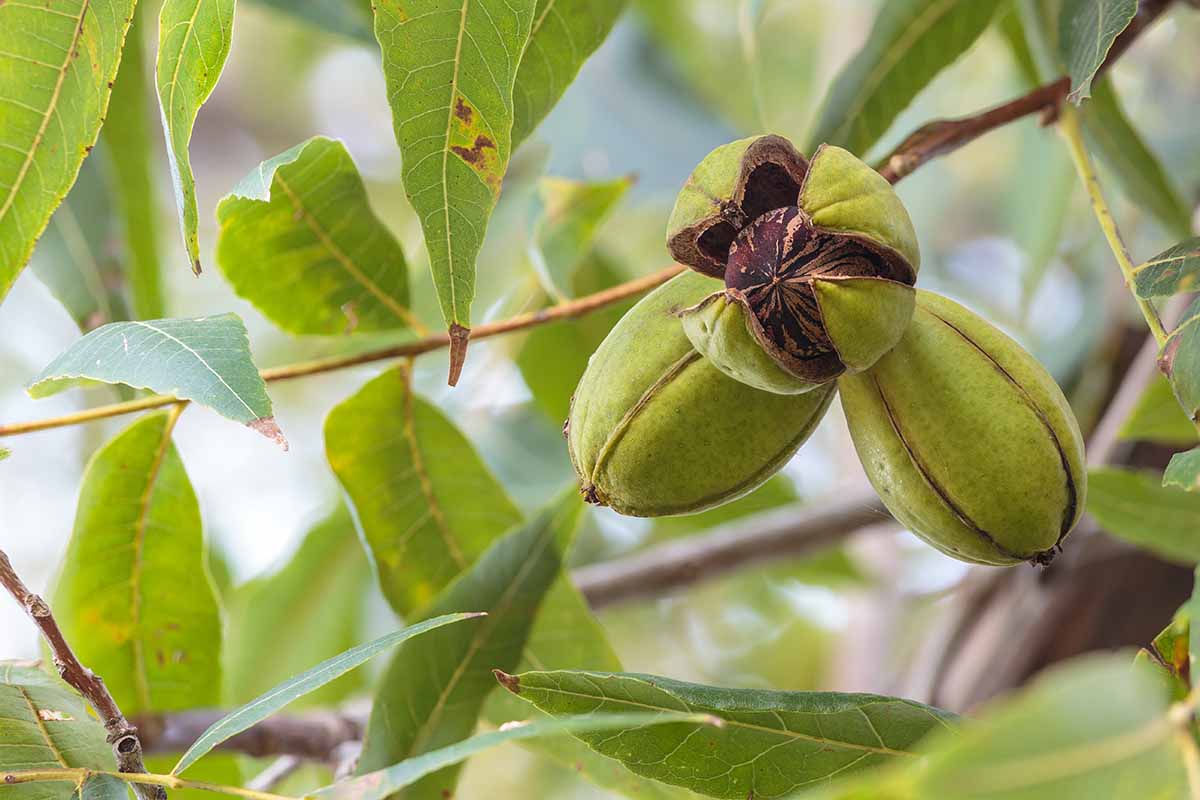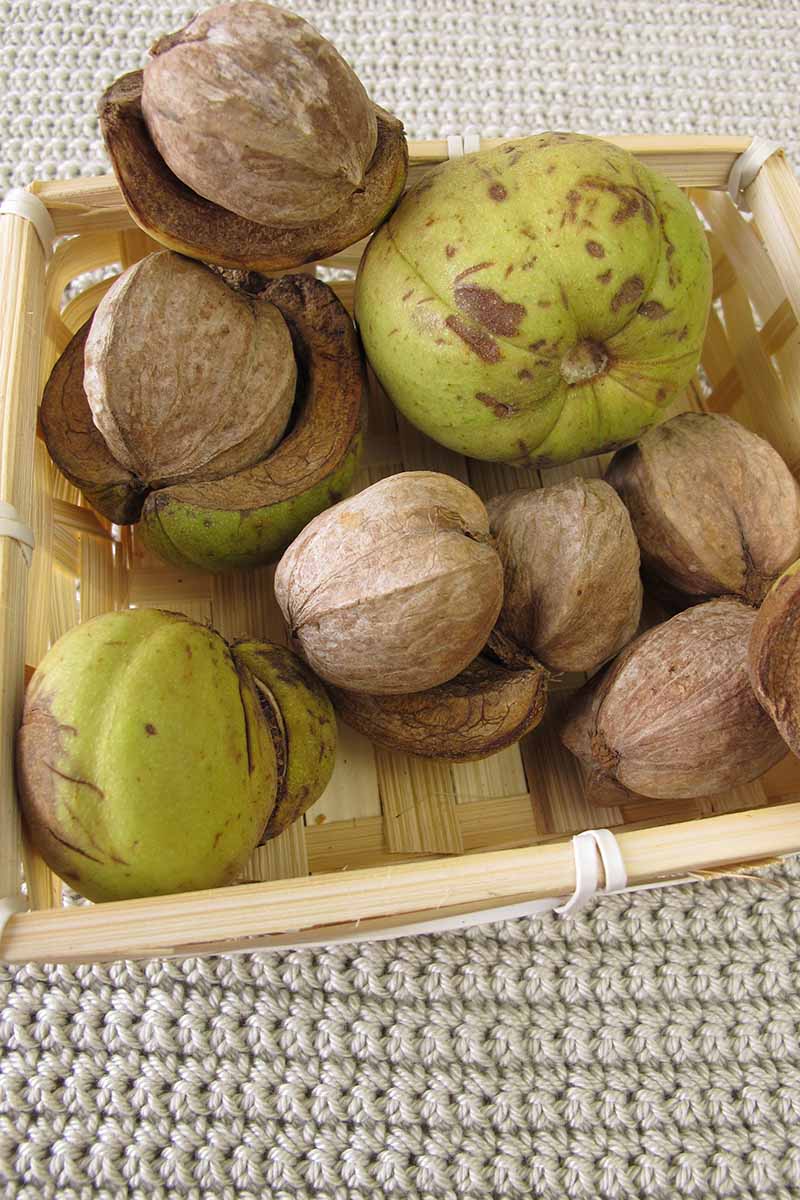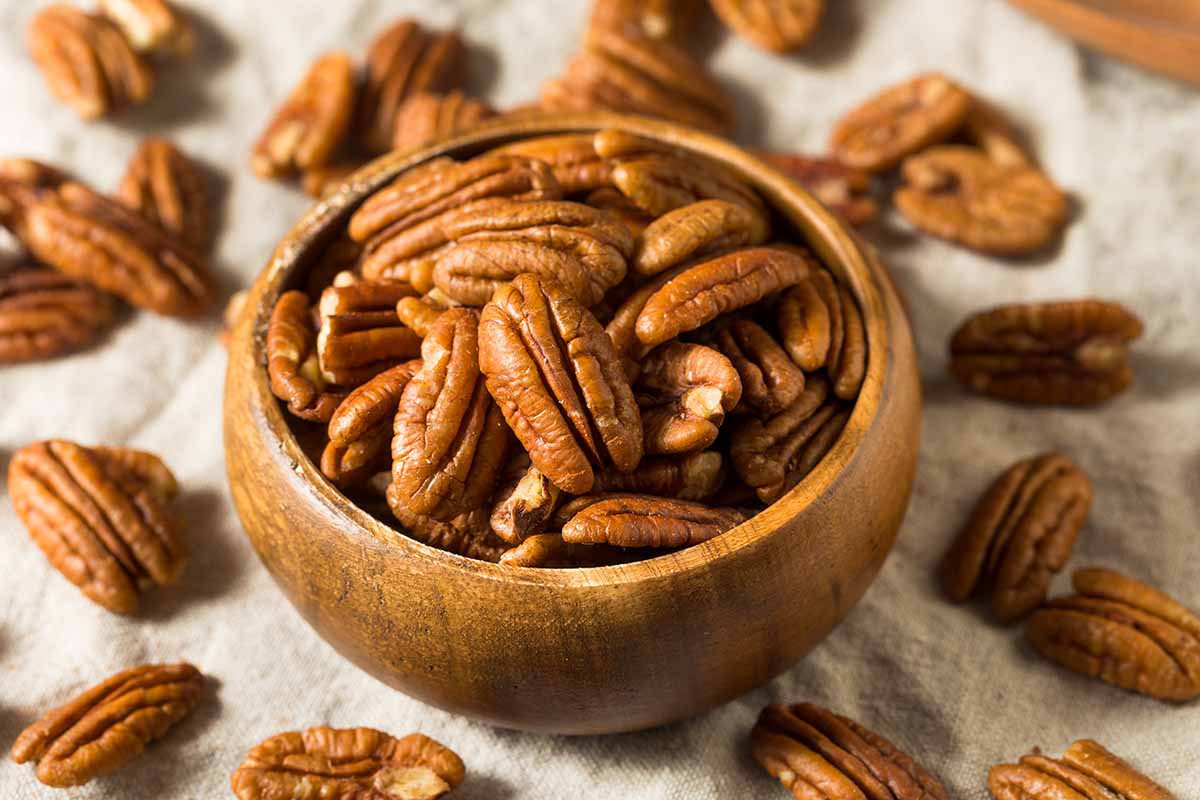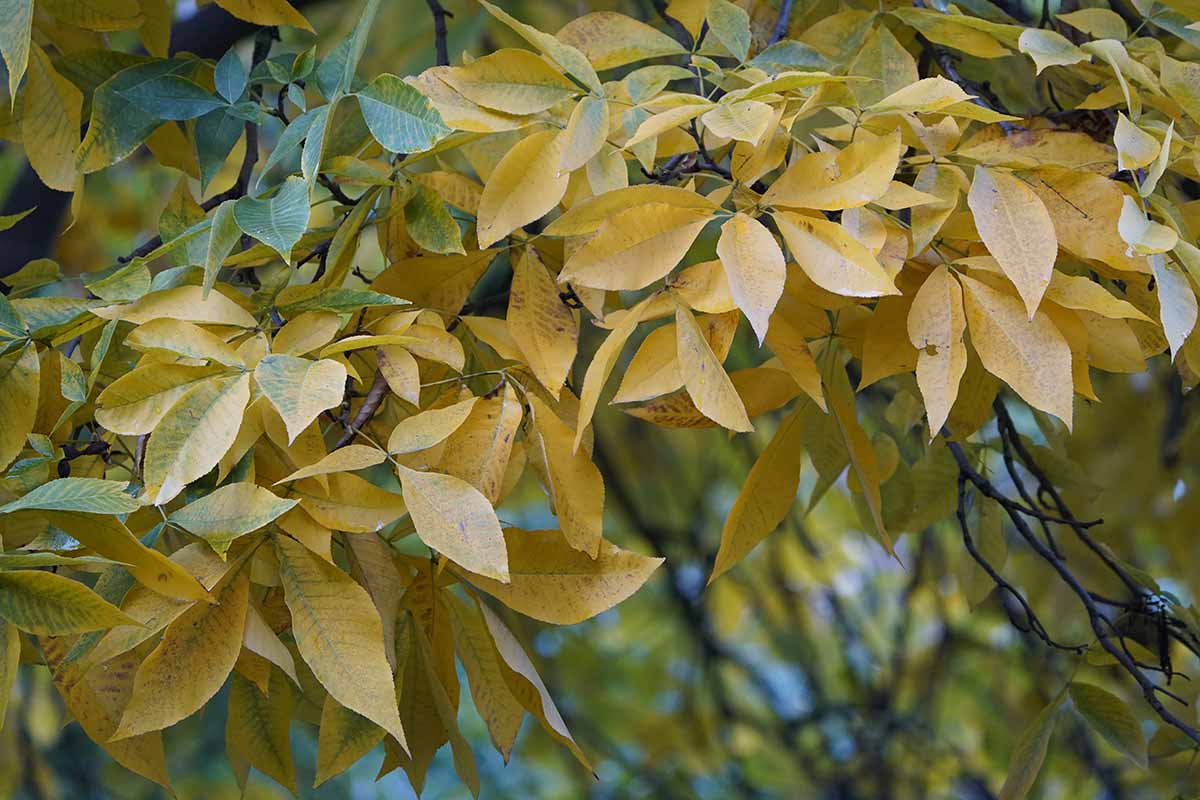Native to North America, China, and Indochina, the Carya genus is composed of three subgenera consisting of typical hickories, pecans, and Asian hickories. In total, the Carya genus includes 19 different species of hardwood, deciduous trees characterized by their pinnately compound leaves, yellow-green flowering catkins, and hard-shelled nuts filled with tasty, edible seeds. We link to vendors to help you find relevant products. If you buy from one of our links, we may earn a commission. These plants serve a valuable role in the ecosystem by providing a high-protein, high-fat food source via their nuts for a variety of animals. These animals then spread the seeds away from the plant that produced them, which allows for new hickories to germinate away from their parents. Humans also enjoy eating nuts from Carya species – especially pecans – and use hickory wood for a variety of products. The high calorie content of hickory wood makes it an excellent choice for wood-burning stoves and bonfires, and meat smoked with burning hickory is well-known for its amazing taste and ability to take any barbecue from good to great. Now that I’ve sold you on the value of hickory trees, read on to learn how to grow these amazing plants yourself! Here’s what’s comin’ atcha: Let’s dive in!
Cultivation and History
Mankind has been utilizing the hickory tree for thousands of years. Archeological evidence of Carya remains associated with human artifacts indicates that human usage of hickory and pecan goes back as early as 6900 BCE in what is now the US state of Illinois. The word Carya actually originates from the Ancient Greek myth of Carya, a Laconian princess who fell in love with Dionysus, the Greek god of wine. Carya’s jealous sisters interfered, and Dionysus infected them with madness, later turning them into rocks. Carya understandably died of sorrow, and Dionysus transformed her into a nut tree, which led to her name being used for the hickory genus. Native American mythology tells us the story of “pokahichary,” a water-pounded hickory nut beverage, which was served by a goddess to spirits of the deceased on their journey to the rising sun after death. Our modern-day usage of the word “hickory” is actually derived from “pokahichary.” Native tribes used Carya for a multitude of applications such as making oil, beverages, bows, baskets, and medicines. European settlers used hickory woods for boxes and barrel hoops, and Americans used the bark for dye and soap-making during the American Civil War. It was even used as the wood of choice for building airplanes back in the days of the Wright Brothers.
Propagation
Hickory trees are grown best by planting seed or via transplanting. Either way, Carya species are monoecious and self-incompatible, so if harvesting hickory nuts is an eventual goal of yours, be sure to plant more than one so they can help each other bear fruit. Let’s examine both propagation methods.
Starting from Seed (AKA The Nuts)
Before planting, hickory seeds require stratification, or long-term exposure to cold and moist conditions. This can be done by either planting the seeds three-quarters to one and a half inches deep in the fall, or by stratifying the seeds indoors. Indoor stratification entails refrigerating the seeds in a moist, 1:1 mixture of peat moss and sand for 90 to 120 days prior to planting in the spring. Planting in the fall, while easier than indoor stratification, does put your seeds at risk from rodent and insect damage, so be sure to keep that in mind when deciding how to stratify your seeds. Either way, you’ll want to give each seed 30 to 50 feet of space in fertile, well-drained soil. Keep the soil moist until the seeds germinate in about four to eight weeks, and continue to water the seedlings as needed until they become established saplings, in a year or so.
Transplanting
Instead of having many shallow, fibrous roots, all varieties of Carya have a main taproot that goes straight down. Therefore, if you want to plant a hickory, it would behoove you to transplant a sapling instead of an established tree so you don’t end up digging a hole to China trying to get it in the ground. To begin, select and prepare your planting area as described below. Once you’ve got your sapling, you’ll want to plant in early spring before growth begins, or in the fall after the leaves drop. Water the planting site three to four days before digging if the soil is dry. When the tree arrives, soak the roots in water for three to six hours prior to planting. When it’s time to plant, dig a hole large enough to fit the entire root system, while ensuring that the root flare is exposed just above the soil line. If it’s a grafted tree you’re working with, keep the bulge of the graft union two to four inches above the soil line. Then, place the tree in the hole, filling in half of the empty space with soil and watering it all in. After that, fill in the rest of the hole with soil and water in well.
How to Grow
Carya species also require good drainage in their soils. Although they can grow in a wide variety of soil textures, it’s going to be a lot harder for clay soils to drain than sandy soils. Luster Leaf Soil Test Kit You’ll also want to ensure that the soil is highly fertile. Adding two to three inches of organic matter such as compost, well-rotted animal manure, or green manure (cover crops) to your soil will go a long way in increasing fertility. Make this amendment an annual thing, and your soil’s fertility is set for life! Ensuring that the surrounding soil drains well and doesn’t get waterlogged will keep your hickories happy! Hickories do best in full sun, but they can grow in partial shade as well. Carya species – especially pecans – also secrete an allelopathic chemical called juglone that prevents the growth of juglone-sensitive plants, so keep that in mind when deciding where to plant. When it comes to irrigation, the surrounding soil should be kept moist until they’re established, which usually takes about a year or so. After that, they should receive ample water from the environment, except during droughts – in which case you should water them slowly and deeply. After your tree has become established, it’s best to fertilize hickories annually as described above, either in the fall or the spring. If working with compost or manure isn’t your speed, commercial fertilizer works, too.
Growing Tips
For planting, choose a location with full sun or partial shade that isn’t under any preexisting canopies or structures such as power lines.Keep the soil moist for the first year until established, then let nature do the watering unless drought occurs, in which case you should water deeply and slowly as needed.Hickories need fertilization, whether it’s via store-bought fertilizer or well-aged manure and compost. Regardless which you choose, make applying it an annual practice.
Pruning and Maintenance
As with any tree, you’ll want to prune diseased, damaged, or dead limbs as you notice them. Spread all this fertilizer three feet out from the trunk under the area covered by the canopy, and water it all in after spreading. GreenView Multipurpose Fertilizer If online shopping ain’t your style, your local garden center should have some great choices in stock too. Heavy pruning can delay nut production, so follow the rule of 25 percent: don’t prune away more than a quarter of the total branches in a single year. Pruning to increase air circulation within the canopy can be a great way of preventing disease. And of course, always be sure to use sterilized tools every time you prune. Eliminating weeds under the canopy will ensure that your Carya doesn’t have to compete for resources with other plants. Manual removal is best.
Species to Select
Regardless of the species you select, if the specimens you transplanted are grafted and of the same cultivar, they cannot reproduce and produce nuts. So if you’re working with grafted hickories, make sure they’re different varieties for cross-pollination. There are 19 species within the Carya genus. All are great specimens, but there are some that simply rise above the rest. Let’s go over the cream of this particular crop.
Herbivores
One of the great things about hickories is the mutually-beneficial relationship that they have with herbivores. They provide food for the animals, and then the animals disperse the seeds to spread more hickories! Its mature, thin-plated bark peels away from the trunk at opposite ends while remaining attached in the middle, giving the tree a “shaggy” look. Shagbark Hickory Andrew Jackson was called Old Hickory because of his toughness, reflecting the durability of C. ovata. Shagbark hickory trees are available from Nature Hills Nursery.
Shellbark Hickory
C. laciniosa is very similar to C. ovata, except that it grows a bit smaller and tends to inhabit wet bottomlands in the wild. This suitability for wet areas carries over into the landscape, as well. Shellbark Hickory Even among hickories, C. laciniosa lumber is exemplary, and it is used for making a variety of tools, sporting implements, and construction timber. Gardeners who are also woodworkers, this is the tree for you! Shellbark hickory trees are available from the Arbor Day Store. These are shipped at two to three feet in height.
Pecan
The largest of the hickories, C. illinoinensis, or pecans, average 70 to 100 feet in height, but they can grow up to 150 feet! Insect issues, disease problems, and high littering tendencies make this a less-than-ideal ornamental tree unless you are prepared to do a lot of maintenance, but its redeeming value lies in the deliciousness of pecans. Many cultivars have been bred over the years to improve fruiting and ease of cultivation, making this a self-sustainable way to acquire ingredients for that pecan pie you’re oh-so-famous for baking. ‘Elliot’ is one cultivar that you may like to plant. It’s known for producing high yields of large nuts, with an excellent flavor and shells that are easy to crack. ‘Elliot’ ‘Elliot’ trees ready for planting are available from Fast Growing Trees. Remember that these trees are not self-fertile – ‘Pawnee’ is a recommended pollinating partner. ‘Pawnee’ You can find ‘Pawnee’ specimens at Fast Growing Trees as well. Read more about growing and caring for pecan trees in our guide.
Managing Pests and Disease
Despite the all-around awesomeness of hickory trees, they’re susceptible to pests and pathogens just like any other plant. Plus, squirrels will sometimes consume infected galls and cause diseased branches or twigs to rain-down – low-effort pruning and disease management for the win!
Hickory Bark Beetle
Like their name implies, hickory bark beetles (Scotylus quadrispinosus) breed under the bark of trees. Chicken Wire Cloche Luckily, Gardener’s Supply Company has a great chicken wire cloche available that’ll help protect your plantings.
Insects
Carya species may suffer infestation by a variety of insect pests. Here, we’ll focus on some of the most common hickory-specific ones. The female then lays eggs in rows of pockets, which the hatched larvae will chew into, forming tunnels that often end up girdling an entire branch – a cruelly organized way to eat through bark. Adults are a fifth of an inch long, brown or black, with four short spines and a truncated abdomen at the apex. They emerge in midsummer and consume leaf stems, causing premature leaf browning. Since the beetles primarily go after unhealthy trees, keeping your hickories healthy will help prevent any problems. But once a tree is infested, it’s best to destroy the plant to prevent widespread infestation. Cutting and burning or peeling the bark and submerging it in water are the best options. However, for high-value plants, you can spray insecticide in early July on the trunk and strong branches to prevent breeding damage.
Hickory Gall Aphid
These pests, Phylloxera caryaecaulis, are light yellow soft blobs with six legs as immatures, and they become winged, soft-bodied adults with a black stripe along the segment of the body where the wings attach.
Hickory Tussock Moth
This pest, Lophocampa caryae, feeds primarily on Carya leaf tissue. Spectracide Insect Spray Note that this and other malathion-containing products are organophosphates that may cause serious health effects. Be sure to read all instructions carefully and heed all recommended directions for application when spraying chemical insecticides in the garden. The larvae are one and a half inches long and covered with white hairs, with a stripe of black hairs running lengthwise down the middle. The adult moths have light brown wings with dark brown veins and white oval-shaped spots. They lay eggs on the undersides of leaves in midsummer. A spray of malathion on the foliage on sight and any overwintering gray cocoons affixed to trees, fences, and other objects should work nicely to keep this pest under control.
Disease
When it comes to preventing disease, healthy plants fare better than unhealthy ones, so a complete disease prevention plan also means keeping your plants as healthy as possible.
Anthracnose
When infected with anthracnose, leaves form reddish-brown or purplish spots, which can then merge into larger blotches. Other than leading to minor defoliation after periods of wet and cool weather, however, anthracnose won’t cause severe damage. To prevent subsequent infection next season, be sure to rake and dispose of all fallen leaves at the end of the season.
Canker
A serious affliction, cankers form around the stubs of dead branches, and will eventually spread and rot wood throughout the plant. There’s no known control, but cleaning out cankers and scraping away discolored wood may help. When it comes to canker, prevention via keeping your hickories healthy is the key.
Witches’-Broom
Witches’-broom isn’t a disease in and of itself, per se, but rather a condition that may come about as the result of simultaneous infection by fungi, viruses, and/or phytoplasmas. If your Carya has witches’-broom, it shows up as clustered bunches of sticks and twigs that form towards the ends of branches. Its presence is most obvious in wintertime, and infection further reveals itself on new springtime growth as white moldiness on leaf undersides. Destroying fallen branches and leaf detritus will help sterilize the area and prevent further spread of disease pathogens.
Harvesting
After 10 to 20 years, depending on the species, your hickory trees will be of fruit-bearing age. Starting in that first year of maturity, come autumn, the ground near your trees will be littered with a full yield of dropped nuts. Taking a crate or heavy-duty sack with you, pick up fallen nuts with a slight crack in the outer husks Remove these, leaving the inner hull that contains the kernel intact. Drop the harvested nuts in your choice of container, and leave the husks behind as a natural compost. It might take a couple of trips before all the husks of the fallen nuts have cracked, and they’re ready to harvest. Shaking branches could help speed things along if any that haven’t fallen yet are within reach. To arborist-wannabees desperate for nuts – climb and shake at your own risk.
Preserving
Non-viable nuts can be diseased, infested with pests, or just plain-old underdeveloped. To tell the good nuts from the bad, take your harvested nuts and soak them in buckets of water. The good ones will stay submerged, while any that float should be discarded. Throw the bad ones away in the garbage. Leave the viable nuts out to dry on a tray or screen in a cool, dry place with good airflow, such as an attic or porch. Outdoors, be prepared to protect your haul from hungry rodents. After the good nuts have cured for a few weeks, store them in a cool, dry location with adequate airflow, where they’ll be good to eat for about a month. If you want to enjoy them for longer, they’ll last for six months in the refrigerator, and a whole year frozen in airtight containers.
Best Uses
These trees are visually stunning, especially in fall when the leaves change color from green to a striking golden-yellow. Before the leaves drop, they make for great shade trees. Hickory wood’s unique combination of durability and flexibility makes it an effective material for products such as tool handles, sports equipment, and drumsticks, to name a few. Carya wood is also used to fuel wood-burning stoves, and for smoking meat. Of course, don’t forget the edible nuts! Palatable hickory nuts like pecans are used commonly for human consumption, while the more bitter nuts are used in animal feed. Armed with the knowledge of how to grow and care for these trees, hopefully you’re now totally jazzed to plant your own! Share your Carya experiences, thoughts, and burning questions in the comments below! If you go nuts for nut trees, read up on all on you need to know in our other nut tree guides:
How to Plant, Grow, and Care for Almond TreesHow to Grow Hazelnut TreesHow to Grow and Care for Chestnuts
